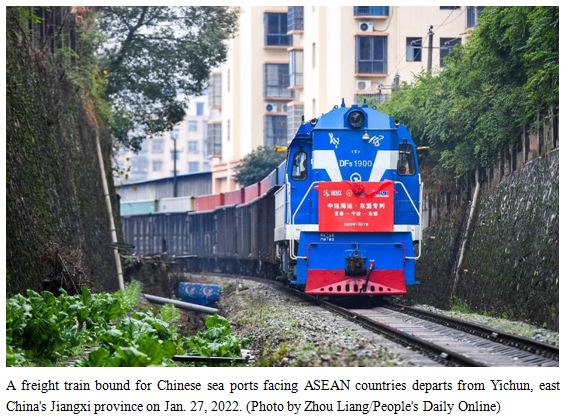By Luo Shanshan, People’s Daily
Jan. 1 this year marked the first anniversary of the Regional Comprehensive Economic Partnership (RCEP). Over the past year, China advanced high-quality implementation of this world’s largest trade deal and the policy dividends of the deal kept releasing, which effectively promoted regional economic integration.
In a smart workshop of Zhejiang Cayi Vacuum Container Co., Ltd. in east China’s Zhejiang province, thermal cups were rolling off the production line and ready to be shipped to European and Asian markets. Last year, the company’s exports exceeded $100 million.
“In early 2022, we got the first RCEP certificate of origin in Zhejiang province, and the tariff rate for our thermal cups to be exported to Japan was reduced to 3.2 percent from 3.9 percent. It saved us over 200,000 yuan ($29,498) last year,” said Gu Lili, manager of the company’s foreign trade department.
According to Gu, the rate has been further lowered to 2.8 percent this year, which makes the company’s products more competitive.
“We are confident in further expanding our exports,” she said.
The reduced cost brought about by lowering tariffs is the most direct benefit of the RCEP for enterprises. According to the trade pact, more than 90 percent of merchandise trade among members that have approved the agreement will eventually be subject to zero tariffs. Those include immediate cutting of tariffs to zero and cutting of tariffs to zero gradually in 10 years. This has significantly boosted the will for trade in the region.

In recent years, China has seen an increase in the number of fruits imported from ASEAN countries. Since the RCEP took effect, agricultural trade between its members has become closer and more frequent. A large number of fruits, such as bananas from Myanmar, longans from Cambodia, and durians from Vietnam, are entering the Chinese market and enriching the choices of Chinese consumers.
Yuan Bo, associate director of the institute of Asian Studies under the Chinese Academy of International Trade and Economic Cooperation, told People’s Daily that RCEP tariff cuts and trade facilitation measures have brought tangible benefits to enterprises, and RCEP members now stand as an important market for Chinese enterprises and an important source of imports from China.
According to the General Administration of Customs, China’s trade with the other 14 RCEP member countries reached 12.95 trillion yuan last year, up 7.5 percent and accounting for 30.8 percent of its total foreign trade.
The country achieved double-digit trade growth with eight RCEP members. In particular, that with Indonesia, Singapore, Myanmar, Cambodia, and Laos was over 20 percent.
Experts believe that RCEP members enjoy high economic complementarity, and the region features complete capital, technological, and labor factors.
Thanks to the accumulation of origin, facilitation of customs procedures and trade, as well as negative list-led investment liberation, RCEP members have further lowered market access for commodities, services, and investment. It promotes the free flow of economic factors in the region and strengthens the division of labor and cooperation among members, thus making industrial and supply chains more reasonable.
The favorable policies under the RCEP framework have constantly enhanced industrial cooperation and increased direct investment between RCEP member countries. Last year, China’s imports and exports of intermediate products to other RCEP member countries reached 8.7 trillion yuan, an 8.5 percent increase, accounting for 67.2 percent of China’s total imports and exports with other RCEP member countries in the same period.
It’s noteworthy that the implementation of the RCEP has brought fiercer market competition to some Chinese enterprises. To promote high-quality implementation of the RCEP,China must build its international competitiveness.
“Though the RCEP has been in effect for only around a year, it has done a good job in facilitating trade, integrating industrial chains, making regional development more attractive, and benefiting small- and medium-sized enterprises and citizens with development results,” said Gu Qingyang, associate professor with the Lee Kuan Yew School of Public Policy, National University of Singapore (NUS).
He believes that China plays an important role in the RCEP, and the country’s robust economic growth in the future will create broader room of development for the trade deal.
It is believed that as RCEP members further fulfill their promises to open up under the trade pact, the potential for regional economy and trade will be further activated and thus contribute more to global economic and trade recovery.












